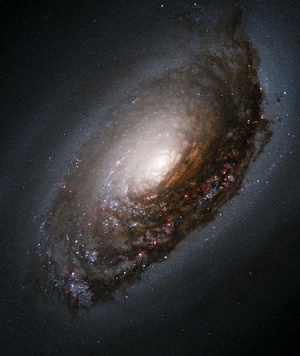Messier 64
The Black Eye Galaxy (also called Evil Eye Galaxy; designated Messier 64, M64, or NGC 4826) was discovered by Edward Pigott in March 1779, and independently by Johann Elert Bode in April of the same year, as well as by Charles Messier in 1780. It has a spectacular dark band of absorbing dust in front of the galaxy's bright nucleus, giving rise to its nicknames of the "Black Eye" or "Evil Eye" galaxy. M64 is well known among amateur astronomers because of its appearance in small telescopes. It is a spiral galaxy in the Coma Berenices constellation.[1]

Messier 64 (M64, NGC 4826) is the famous Black Eye galaxy, sometimes also called the "Sleeping Beauty galaxy." The conspicuous dark structure is a prominent dust feature obscuring the stars behind. This feature also enables one to determine, or at least estimate, which of the galaxy's sides is nearer and which more remote; in case of M64, it seems that the southern side is nearer to us.
J.D. Wray, in his Color Atlas of Galaxies, points out that M64 may be taken as prototype for a class of galaxies called "ESWAG", for Evolved Second Wave (star forming) Activity Galaxy. As becomes evident in color photos, the main spiral pattern is consisted of an intermediate aged stellar population. Stellar formation has first evolved outside following the density gradient, forming stars as long as there was sufficient interstellar matter available, and then dying out slowly. As the matter was flowing back from the evolved stars, by stellar wind, supernovae, and planetary nebula activity, more and more interstellar matter could accumulate again, so that finally there was enough matter to start the formation of new young stars again. This second wave of star formation has apparently reached now the region where the dark dust lane appears. The dust feature is well visible even in smaller telescopes. M64 was recently shown to have two counter rotating systems of stars and gas in its disk: The inner part of about 3,000 light years radius is rubbing along the inner edge of the outer disk, which rotates opposite and extends up to at least 40,000 light years, at about 300 km/sec. This rubbing process is probably the reason for the observed vigorous star formation process, which is currently under way, and can be observed as the blue knots imbedded in the peculiar dust lane on one side of the nucleus. It is speculated that this peculiar disk and dust lane may be caused by material from a former companion which has been accreted but has yet to settle into the mean orbital plane of the disk.
M64 was discovered by Edward Pigott on March 23, 1779, just 12 days before Johann Elert Bode found it independently on April 4, 1779. Roughly a year later, Charles Messier independently rediscovered it on March 1, 1780 and cataloged it as M64. However, Pigott's discovery got published only when read before the Royal Society in London on January 11, 1781, while Bode's was published during 1779 and Messier's in late summer, 1780. [2]
HGS Session References
HGS Sessions - Clearing Dragon Moth Grid - 3/10/2015 [3]
References
Found in HGS Manual on Page 108